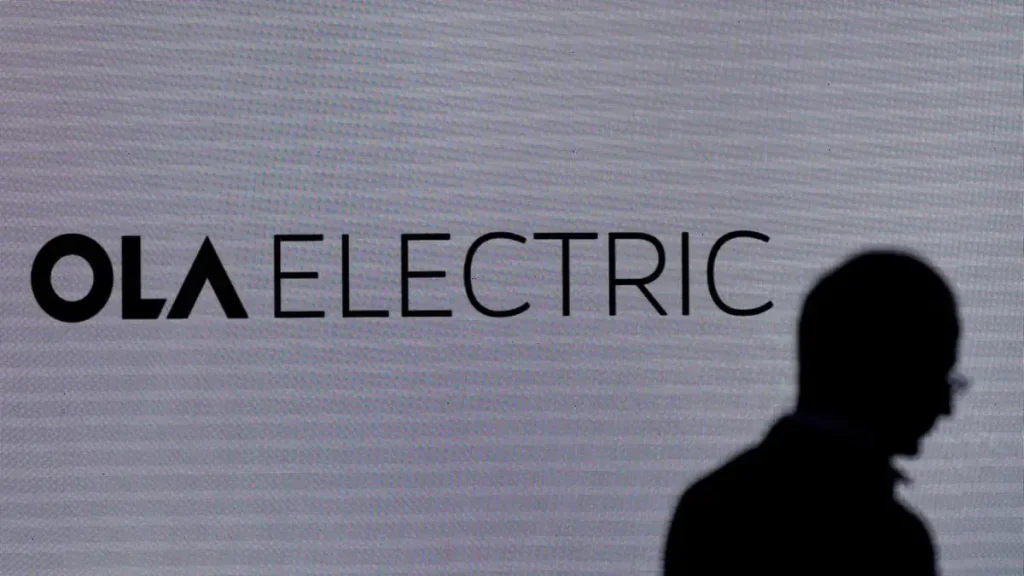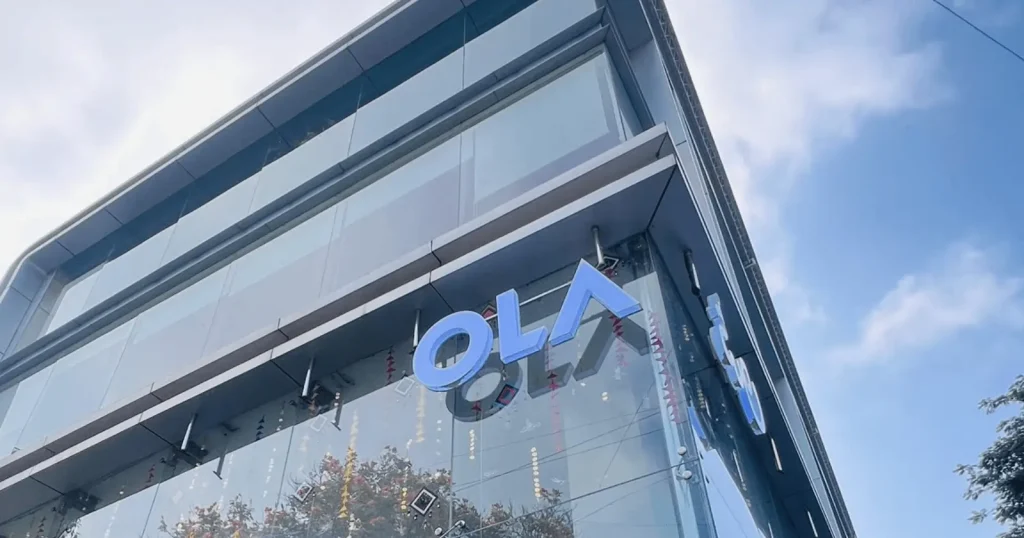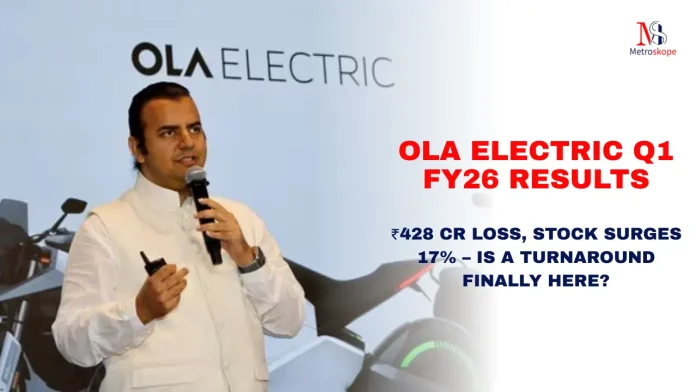Ola Electric, India’s leading electric two-wheeler manufacturer, has announced its Q1 FY26 results. While the headlines scream of a ₹428 crore loss and a 50% drop in revenue, the market responded with a 17% stock rally.
Why? The answer lies in cost control, strategic moves, and a margin-led narrative. Let’s explore the Ola Electric Q1 FY26 results, and why the Ola Electric shares surged, despite the fact that the Ola Electric loss widened.
Ola Electric Q1 FY26 Financial
| Metric | Q1 FY26 | Q1 FY25 | % Change YoY |
|---|---|---|---|
| Net Loss | ₹428 crore | ₹347 crore | +23% loss |
| Revenue | ₹828 crore | ₹1,644 crore | –49.6% |
| EBITDA (Auto) | ₹(237) crore | ₹(205) crore | –15.6% |
| Auto Gross Margin | 25.6% | 13.8% | +85% |
| Delivery Volume | 68,192 units | ~1,25,000 units | –45.5% |
Despite a higher loss YoY, Ola Electric’s sequential improvement from the ₹870 crore loss in Q4 FY25 to ₹428 crore indicates major operational tightening.

Revenue Breakdown & Sales Volume
The revenue halved YoY due to:
- Lower delivery volumes: down to 68k units from 1.25 lakh.
- Reduced incentives and delayed orders due to FAME-II policy revisions.
- Customer resistance over price increase and EV infrastructure gaps.
However, revenue rose QoQ from ₹611 crore to ₹828 crore, a 35% jump — indicating volume recovery is in motion.
Why Ola Electric Shares Surged Despite Loss
The Ola Electric shares surge can be attributed to:
- Improved auto gross margin: from 13.8% to 25.6%.
- Cost reduction across departments.
- Vertical integration (in-house motor tech).
- Rare-earth-free motor development – addresses global supply chain risk.
- Auto segment EBITDA turned positive in June 2025.
“Investors are betting on margin-led recovery, not volume-led chaos,” says a Motilal Oswal analyst.
The Ola Electric stock jumped over 17% in a day, signaling strong market sentiment despite the headline losses.
Ola Electric’s Operational Highlights
- Launch of Gen 3 scooters: 80% of Q1 sales came from this upgraded model.
- MoveOS+ software integration for smart scooter features.
- Factory utilization improved, with leaner operations.
- High warranty reduction due to improved product reliability.
These factors helped offset top-line decline and shifted focus to sustainable operations.
Cost Efficiency & Project Lakshya
Ola Electric launched Project Lakshya to achieve cash neutrality:
| Cost Area | Before (₹/month) | After (₹/month) |
|---|---|---|
| Auto Opex | ₹178 crore | ₹105 crore |
| Consolidated Opex | ₹210 crore | ₹150 crore |
This aggressive cost optimization plan includes:
- Automation of assembly lines.
- Layoffs in non-core functions.
- Reduced marketing spends and retail overheads.
This strategic shift is essential to understanding why the Ola Electric shares surged despite financial pressure.
Margin & EBITDA Trends
Margin Outlook
- Current Auto EBITDA Margin: –11.6% (was –90.6% in Q4 FY25!)
- Gross Margin Target for FY26: 35–40%
- Revenue Target: ₹4,200–4,700 crore
Positive Triggers
- Auto EBITDA turned positive in June 2025.
- Guidance suggests consistent profitability from Q2 FY26.
The rise in operational margin is a key reason Ola Electric loss widened but investor faith remains intact.
Future Strategy & Product Innovation
Ola is now focusing on technology-first product differentiation:
- Launch of rare-earth-free motors from Dec 2025.
- Filing for PLI (Production Linked Incentive) certifications for new products.
- Development of electric motorcycles and mass commuter e-scooters.
- Battery innovation with fireproof modules and thermal stability.
Vertical integration will further reduce cost and increase efficiency, helping to tighten margins.

Market Risks & Challenges Ahead
Despite optimism, challenges exist:
Competitive Pressure
- Rivals like TVS, Ather, and Bajaj are scaling faster.
- Ola’s delivery volumes fell nearly 50% YoY.
Policy Uncertainty
- Delays in FAME-II subsidy disbursements.
- Changing EV policy landscape across states.
Customer Sentiment
- After-sales service criticism.
- Concerns about Ola showroom closures in Maharashtra.
The Ola Electric Q1 FY26 results show improvements, but the path forward remains complex.
Analyst Take
While the Ola Electric loss widened year-over-year, the market has acknowledged the turnaround narrative. Here’s why:
- Costs are under control
- Gross margins have more than doubled
- Auto business EBITDA turned positive
- Market sees long-term potential in rare-earth-free and vertically integrated models
Final Verdict: Ola Electric may be entering a new operational maturity phase. The current focus is not just selling scooters—but selling a profitable and sustainable EV future.
“If Ola can continue its efficiency run, this quarter could mark the inflection point for India’s EV sector.”
FAQs
Q1. Why did Ola Electric report a ₹428 crore loss in Q1 FY26?
Answer: Due to a 50% drop in revenue from lower deliveries and changing government subsidy frameworks.
Q2. Why did Ola Electric shares surge despite the loss?
Answer: Because of margin improvement, cost-cutting success, positive EBITDA in June, and strategic innovation.
Q3. What is Ola Electric’s future strategy?
Answer: Scaling Gen 3 scooters, rolling out rare-earth-free motors, and achieving margin-driven profitability.
Q4. Is Ola Electric on track to become profitable?
Answer: Yes. With positive auto EBITDA in June and forecasted gross margins of 35–40%, breakeven is within reach in FY26.

